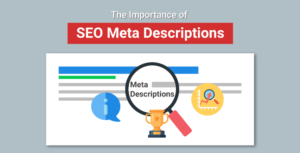Ever wonder where those little snippets you see on the search engine results pages come from?
While there are no guarantees when it comes to Google, these little snippets are often pulled from the meta descriptions you or your web crew create.
So, what is a meta description and how do you go about writing one?
Here’s what senior living marketing teams should know…

What is a Meta Description?
A meta description is a tag for your senior living blog post or web page. It shows under the title of your page on the search engine results page (SERPS).
The meta description helps Google better understand what your page or post is all about. Sometimes you’ll get lucky and they’ll use your copy.
While it doesn’t directly impact your SEO, a well-written meta description improves your click-through-rate (CTR). A good CTR does help pump up your SEO.
Wondering what you should include in your meta descriptions?
It’s a great question and we are happy to share a few tips to help you make the most of your meta descriptions.

Tips for Writing a Senior Living Meta Descriptions
To improve the odds of Google utilizing your copy in the meta description of your senior living blog posts and pages, keep these tips in mind:
- Use an active voice: The meta description is your opportunity to pull potential residents and their families in to your site. By using an active voice, you’ll likely motivate them to take action. That action is, of course, to visit your site. Along those same lines, make sure you include the next step you’d like them to take. That is, encourage them to click through to your page and learn more.
- Incorporate key word/phrase: Make sure to include the key words or phrase you are targeting for that page. By tying the intent of the page with the keyword in to your meta description, you make it clear what content visitors will find.
- Character count matters: As is the case with most things Google, there isn’t a hard and fast rule on how many characters you need. The general rule of thumb is about 120 characters, but up to 155 might also work.
- Make it original: One mistake we’ve encountered when we take over a senior living company’s blog is that they’ve been using the same meta description for every page and post. It’s not done in attempt to trick Google, most companies believed they should have one good meta they post and re-post. Instead, just like the content on each page on your website should be unique, so too should this description.
- Represent the content: Another issue we’ve noticed is senior living companies inadvertently hiring black hat SEOs. They’ve pull some shady business with meta descriptions. For example, they’ll create a title and meta that tap in to trending topics just to push web traffic to a page. But the meta and title don’t represent the content on the site. The bump you get in traffic makes the SEO team look like heroes in the short run. In reality, all they are doing is running up your bounce rate and making your page less appealing for Google.
If you keep these pointers in mind when you are writing your senior living meta descriptions or reviewing those your SEO crew has created for your website, you’ll likely have a good showing with Google.
Let SCCS Help Provide Blog Content
If you are struggling to get quality senior living content posted to your blog on a consistent basis, drop us a note. SCCS will have a few spots opening up for our blog services in early 2022. We can set up a time to talk and see if we are a good fit to support your content marketing goals.